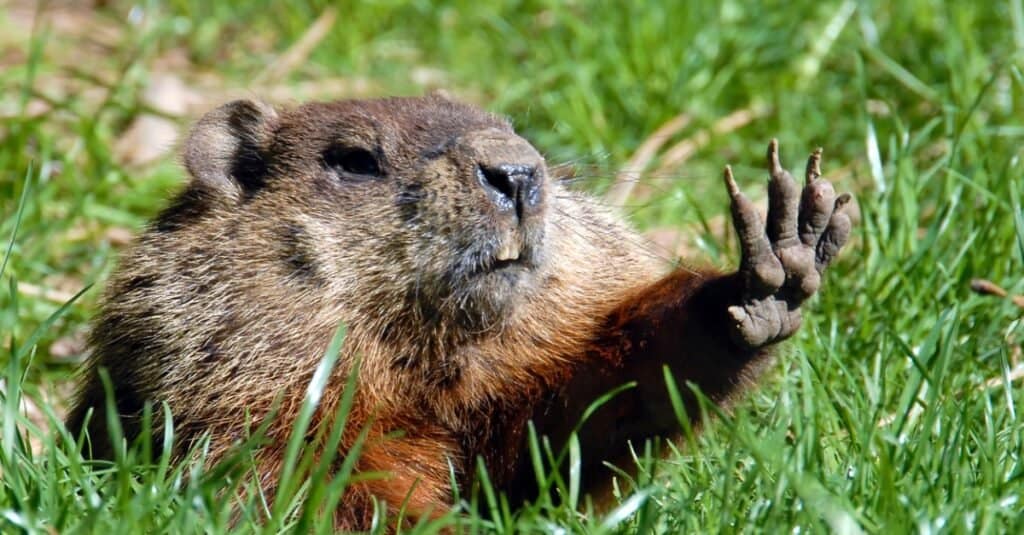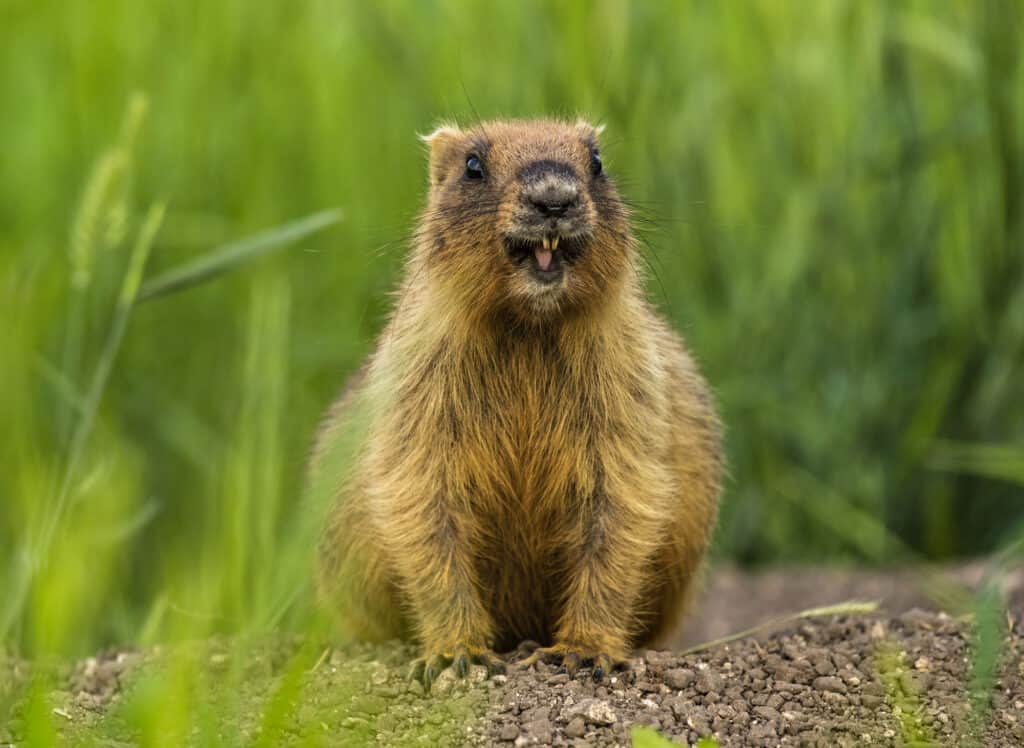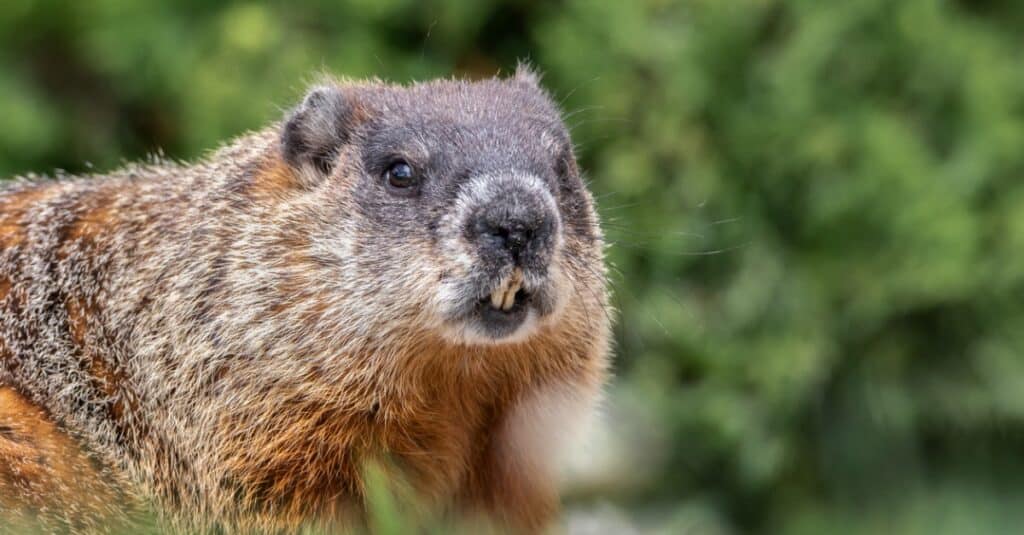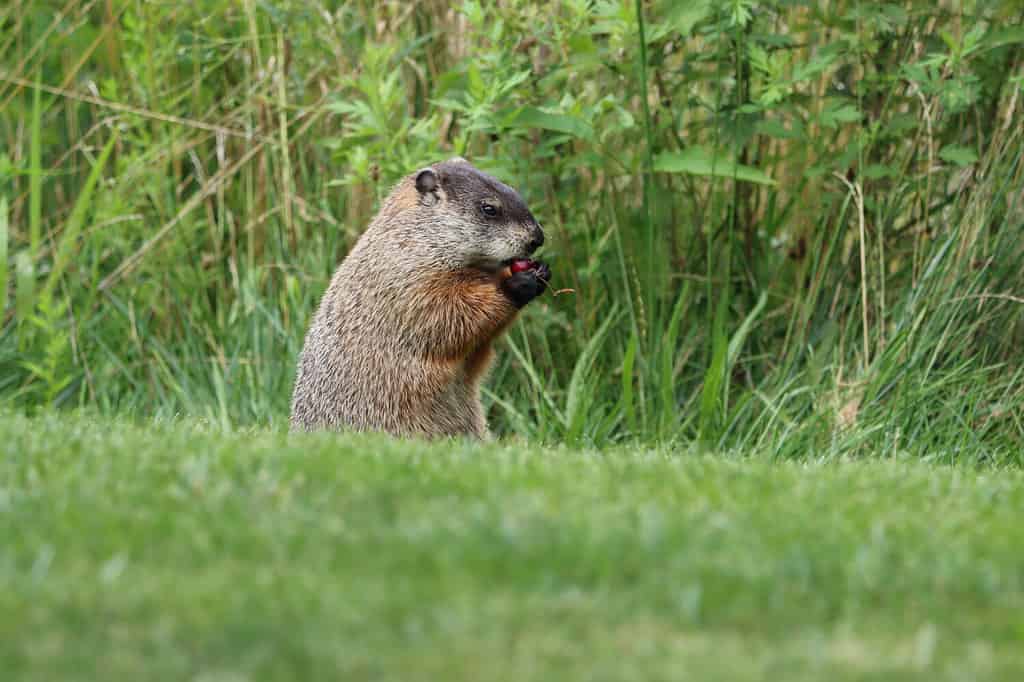Groundhogs live in the central-eastern and the northeastern United States and Canada. These rodents are often viewed as pests as they love treating people’s gardens as their personal pantries. If you have a garden and want to prevent groundhogs from destroying it, it would help if you understood their sleep behavior. So, are groundhogs nocturnal or diurnal? This question is the first place to start when protecting your precious garden from groundhogs.
Groundhogs Are Not Nocturnal or Diurnal but Crepuscular

Groundhogs are crepuscular, as they are primarily active at dusk and dawn.
©iStock.com/mirecca
Groundhogs sleep at night, waking to engage in their foraging activities around dusk and dawn. Considering the seasons, groundhogs are more active from spring to fall as the temperatures are warmer. This busy period means that the temperature and food sources available influence their activity and sleep behavior.
Groundhogs are typically less active during the summer and stay in their burrows to escape the heat. To clarify, being diurnal means being active during daylight hours. Crepuscular activity means being primarily active at dusk and dawn. So, while groundhogs are busy in the daytime, they confine their activities to the start and end of the day.
Groundhog Nocturnal Sleep Behavior
Groundhogs are crepuscular, not nocturnal, but this may change for specific reasons. The amount of time groundhogs sleep is between 16 and 20 hours a day, which is mostly at night but depends on their environmental factors. Groundhogs are usually active at dawn and dusk as the sun rises and sets. This dynamic behavior is likely due to most of their predators being less active during these times. Avoidance of predators makes it safer to forage and hunt during these hours.
An additional reason for this conduct is that groundhogs are solitary animals. They prefer being alone; dusk and dawn are generally the quietest times of the day. However, their habitats and locations dictate their sleeping and foraging periods. For example, a groundhog living near a farm may be more active in the late morning. Farms are usually the most active at dawn and earlier in the morning, which may disturb the groundhog.
Nocturnal and Diurnal Groundhog Hibernation Behavior

Groundhogs prepare for hibernation by eating
as much as possible to build their nutrient and fat reserves.
©toha90/Shutterstock.com
Groundhogs enter a state of true hibernation from October to March to avoid winter. They hibernate for roughly three months, but groundhogs often hibernate for more extended periods if they live in the colder northern regions. Males wake up before the females and build separate winter burrows. These animals reach their maximum body weight before dropping their body temperature to as low as 35 degrees Fahrenheit to prepare for hibernation.
Hibernation, Torpor, and Arousal
While hibernating, groundhogs go in and out of torpor and states of arousal. Torpor is when they lower their body temperatures and activity. Arousal is when they briefly wake up to eat or excrete waste. By the end of February, groundhogs will have lost most of the extra body fat they gained by preparing for the winter. A study of groundhog hibernation found that they averaged 41 hours of arousal periods throughout their hibernation. In comparison, the intermediate torpor periods were 128 hours.
Hibernation Stages
There are two main stages to true hibernation. The first stage is known as the preparation phase. Groundhogs prepare for extended torpor during this phase by eating as much food as possible to reach their maximum body weight. They do so during the day as groundhogs are not nocturnal. The purpose of excess foraging is to store nutrients in their body that will metabolize while they are hibernating. Before starting hibernation, groundhogs conserve their fat reserves and reproduce. Once they finally reach hibernation, the groundhog will be at its maximum weight for the year.
The second stage is the hibernation phase. The groundhog enters the hibernation phase by decreasing its metabolism by up to 90%. Groundhogs will also slow their heartbeat to four to 10 beats per minute and reduce their body temperature to as low as 35 ºF.
They also have short periods of being awake during hibernation. Experts do not entirely understand why this happens but assume that it maintains their body functions at the cellular level and is necessary for excretions. Once this phase ends, the groundhog will have lost roughly half its body weight. In some cases, the winter will last longer than usual, resulting in the groundhog extending its torpor. This extension can be deadly for some groundhogs, especially younger ones, as they will consume too much of their body reserves and eventually die.
A Groundhog’s Non-Nocturnal Daily Schedule
Because groundhogs are not nocturnal, they spend most of their day eating and foraging. These little mammals are mainly herbivores, so they need large amounts of food to sustain themselves. Because of this, groundhogs must forage and eat a third of their body weight in vegetation daily. Most adults weigh roughly 10 pounds, so they should eat over three pounds of fruit, vegetables, and grass daily. Groundhogs do not forage in groups as they are solitary animals. The only time these animals choose to interact with other groundhogs is during mating season. But they communicate with each other to signal predators by making high-pitched noises that are discernible over distances.
Where Do Groundhogs Sleep?
Groundhogs are not nocturnal so they sleep at night in burrows that they build themselves. These animals make complex burrow systems in which they rest, raise their young, and store food. Their shelters also offer protection from predators and harsh elements. At night, when the temperatures drop, groundhogs go deeper into their holes to escape the cold and conserve the heat in lower areas where it is warmer. These animals also hibernate in their burrows, which provide warmth and protection from the cold winter and predators.
Groundhogs Are Not Adjusted To Being Nocturnal

Groundhogs sleep in a complex system of burrows that they build for sleep, storage, and protection.
©iStock.com/Jean Landry
Groundhogs have good day vision and can see for a distance of 250-300 yards away. Because of this, groundhogs can see danger from afar and avoid it before it can affect them. Groundhogs also see colors and prefer dark colors over bright ones, so they will probably be more comfortable around someone wearing darker-colored clothing. But groundhogs have poor night vision, which is why they are not nocturnal. Because of this, groundhogs prefer to stay in their burrows at night as they cannot see predators and avoid danger.
Nocturnal vs. Diurnal: What’s The Difference?
Navigate to Nocturnal vs. Diurnal: What’s The Difference? for further information about the nocturnal and diurnal phenomenon in various living creatures.
Bonus: Is it a Good Idea to Feed Groundhogs?

Groundhogs are cute and fun to watch.
©Lisa Basile Ellwood/Shutterstock.com
Groundhogs are often considered to be a nuisance but they are also very cute and have charmed many people into feeding them just to watch them eat happily. Is this a good idea? Probably not. Here are a few reasons not to feed a groundhog:
- Overfeeding. Groundhogs will eat whatever they can get and they aren’t going to resist your offerings. This could lead to obesity and other health issues.
- Disease transmission. Woodchucks can carry parasites and diseases that could be transmitted to you or your pets.
- Dependency on humans. It’s not a good idea for a wild animal to become dependent on humans and fail to pass on foraging techniques to offspring.
If you want to throw out the occasional treat – make sure that it is a fresh fruit or vegetable. Processed food and sugary treats can make groundhogs sick.
The photo featured at the top of this post is © samray/Shutterstock.com
Sources
- New Jersey Agricultural Experiment Station Rutgers, Available here: https://njaes.rutgers.edu/e361/
- Live Science, Available here: https://www.livescience.com/64672-groundhog-day-hibernation.html
- JSTOR, Available here: https://www.jstor.org/stable/1376964
Thank you for reading! Have some feedback for us? Contact the AZ Animals editorial team.






